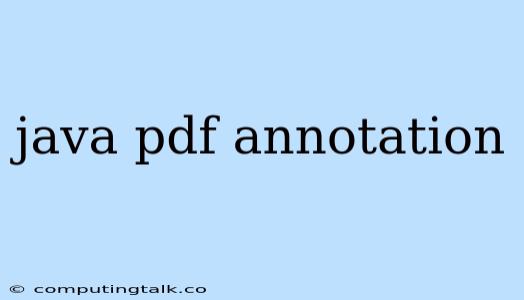Java is a popular programming language that is used for developing a wide range of applications, including desktop applications, web applications, and mobile applications. One of the key features of Java is its ability to interact with various file formats, including PDF files. PDF files are commonly used for sharing documents, reports, and presentations.
Adding Annotations to PDF Files using Java
Annotations are a valuable feature of PDF files, as they allow users to highlight text, add comments, draw shapes, and perform other actions on the document. This can be particularly useful for collaborating on documents or for reviewing and providing feedback. Java provides a number of libraries that can be used to add annotations to PDF files.
Popular Libraries for Java PDF Annotations
Here are a few popular libraries that Java developers can use to add annotations to PDF files:
- Apache PDFBox: A free and open-source Java library that provides a comprehensive set of tools for working with PDF files. It offers a wide range of functionalities, including annotation creation.
- iText: A commercial Java library that provides advanced features for working with PDF files, including annotation capabilities. iText allows for a high degree of customization and flexibility in annotation creation.
- Aspose.PDF for Java: Another commercial library that offers a rich set of APIs for working with PDF files, including annotation management. Aspose.PDF provides a wide range of annotation types and customization options.
How to Add Annotations using Java
To add annotations to a PDF file using Java, you will need to choose a library, import it into your project, and then use its API to create and apply annotations.
Here is a basic example of how to add a text annotation to a PDF file using Apache PDFBox:
import org.apache.pdfbox.pdmodel.PDDocument;
import org.apache.pdfbox.pdmodel.PDPage;
import org.apache.pdfbox.pdmodel.PDPageContentStream;
import org.apache.pdfbox.pdmodel.interactive.annotation.PDAnnotationText;
public class AddTextAnnotation {
public static void main(String[] args) throws Exception {
// Load the existing PDF file
PDDocument document = PDDocument.load("input.pdf");
// Get the first page
PDPage page = document.getPage(0);
// Create a new text annotation
PDAnnotationText annotation = new PDAnnotationText();
annotation.setContents("This is a text annotation");
annotation.setRectangle(new PDRectangle(100, 100, 100, 20));
// Add the annotation to the page
page.getAnnotations().add(annotation);
// Save the modified PDF file
document.save("output.pdf");
// Close the document
document.close();
}
}
This example demonstrates how to create a text annotation with specific content and position it on the first page of the PDF file.
Different Types of Annotations
Java libraries offer various types of annotations, each serving a specific purpose. Some common types include:
- Text Annotations: For adding notes, comments, or explanations to the document.
- Highlight Annotations: To highlight specific sections of text.
- Ink Annotations: For drawing freehand lines or shapes.
- Stamp Annotations: To add predefined stamps or symbols to the document.
- Link Annotations: To create hyperlinks to other documents or websites.
Customization Options
The libraries also allow you to customize the appearance and properties of annotations. You can:
- Change the font size, color, and style of text annotations.
- Modify the color and thickness of highlight annotations.
- Adjust the size, shape, and color of ink annotations.
- Select from predefined or custom stamps for stamp annotations.
- Define the destination URL and appearance of link annotations.
Troubleshooting and Best Practices
When working with Java PDF annotations, it's important to follow best practices and troubleshoot potential issues:
- Proper Library Integration: Ensure the chosen library is correctly integrated into your project, and its dependencies are resolved.
- Version Compatibility: Use compatible versions of libraries and dependencies to avoid conflicts.
- Error Handling: Implement appropriate error handling mechanisms to gracefully handle exceptions that may arise during annotation operations.
- File Formats: Pay attention to the supported PDF file formats and version compatibility. Some libraries might have limitations with specific PDF versions.
- Resource Management: Properly release resources like PDF documents and streams to avoid memory leaks or resource exhaustion.
- Testing and Validation: Thoroughly test your code and validate the output PDF file to ensure the annotations are applied correctly.
Conclusion
Java offers powerful tools and libraries for adding annotations to PDF files. By leveraging these libraries, you can enhance your PDF applications with features that allow users to interact with and enrich the document content. Remember to choose the appropriate library, understand its API, and follow best practices for effective and error-free annotation operations.
